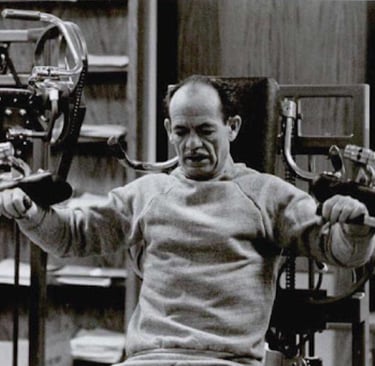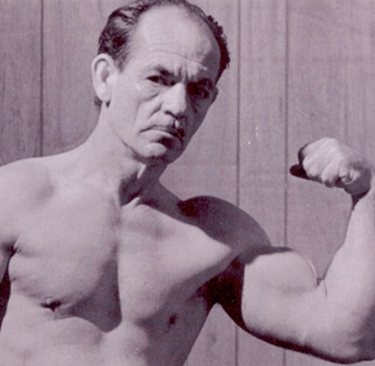Arthur Jones: The Maverick Mind Behind High-Intensity, slow movement Training and Nautilus
Arthur Jones, the maverick behind High Intensity, slow movement, one set to failure training.
Bruce Black
8/8/20254 min read


Arthur Jones: The Maverick Mind Behind High-Intensity, Slow Movement Training and Nautilus
In the annals of exercise science and physical culture, few figures loom as large and as controversial as Arthur Jones. A true polymath—inventor, aviator, philosopher, and conservationist—Jones's most enduring legacy is arguably his profound influence on the world of strength training. He was the founder of Nautilus, a company that revolutionized gym equipment, and the fervent advocate for a training methodology that, at the time, was radically counterintuitive: High-Intensity Training (HIT), emphasizing slow-motion, one-set-to-failure workouts.
Born in 1926, Arthur Jones was a man driven by an insatiable curiosity and an intensely critical mind. He questioned prevailing wisdom in nearly every field he touched, and exercise was no exception. In the mid-20th century, the dominant paradigm in strength training was characterized by high volume: many sets, many repetitions, often with relatively light weights. Jones observed what he considered to be inefficiencies and misconceptions in this approach. He believed that traditional training protocols were far too time-consuming, overtrained muscles, and ultimately failed to deliver optimal results.
His early observations led him to a fundamental premise: that for a muscle to grow stronger, it needed to be pushed to its absolute limit, briefly, and then allowed ample time to recover. This concept, simple in its articulation, formed the bedrock of his "High-Intensity Training" philosophy. Jones was not interested in simply moving weights; he was obsessed with stimulating maximum muscle growth and strength gains in the most efficient manner possible.
The embodiment of Jones's philosophy came in the form of Nautilus equipment. Frustrated with the limitations of existing free weights and machines, he began designing his own. The defining characteristic of Nautilus machines was their unique cam design, a snail-shaped pulley that varied resistance throughout the range of motion. Jones argued that traditional weights provided uneven resistance, making exercises harder at some points and easier at others, thereby failing to tax the muscle throughout its entire contraction fully. The Nautilus cam, he posited, ensured that the muscle was maximally loaded at every point, providing what he termed "full-range exercise with automatically variable resistance." This innovation was a direct practical application of his theoretical understanding of how muscles adapt to stress.
Jones's research into high-intensity strength training was meticulously detailed and often presented with an almost evangelical fervor. He advocated for workouts that were brief, infrequent, and intense. The core tenets of his HIT philosophy included:
One Set to Failure: This was the most controversial aspect of his approach. Jones argued that if a set was truly performed with maximum intensity, pushing the muscle to momentary muscular failure (the point where another repetition cannot be completed with good form), then additional sets for that muscle group were not only unnecessary but detrimental. He believed that the single, intense set provided the necessary stimulus for growth, and further sets would merely deplete recovery resources.
Slow Motion Repetitions: Jones was a staunch advocate for controlled, slow movements, typically suggesting 2-4 seconds for the concentric (lifting) phase and 4-6 seconds for the eccentric (lowering) phase. This was to eliminate momentum, keep constant tension on the muscle, and increase the time under tension, thereby maximizing muscular fatigue and stimulus.
Minimal Rest Between Exercises: To keep workouts brief and intense, Jones recommended minimizing rest between exercises, moving from one machine to the next to keep the heart rate elevated and maintain a high level of overall intensity.
Infrequent Training: Because of the extreme demands placed on the body by pushing muscles to failure, Jones emphasized the critical importance of recovery. He typically recommended training a full-body routine no more than three times per week, with at least 48-72 hours of rest between sessions for optimal recovery and growth.
Jones didn't just theorize; he conducted extensive experiments, often on himself and a select group of dedicated trainees, including bodybuilders like Casey Viator. These experiments, though frequently anecdotal and lacking the rigorous peer-review standards of modern scientific research, provided compelling evidence to Jones and his followers that his methods yielded impressive results. Viator, under Jones's tutelage, famously gained a remarkable amount of muscle mass in a short period, further fueling the HIT movement.
The impact of Arthur Jones and Nautilus on the fitness industry was immense. Gyms across America began installing Nautilus machines, and his HIT principles found a dedicated following among athletes, bodybuilders, and fitness enthusiasts alike. His writings, particularly in publications like Iron Man magazine, were avidly read and debated. He challenged the status quo, forcing the fitness community to reconsider fundamental principles of strength training.
While some of Jones's more extreme claims and his often confrontational style drew criticism, the core principles of High-Intensity Training—the importance of progressive overload, muscle failure, controlled movements, and adequate recovery—have stood the test of time and are now widely accepted in various forms. Modern strength and conditioning programs, even those not explicitly labeled "HIT," often incorporate elements of his philosophy.
Arthur Jones eventually sold Nautilus, turning his attention to other passions, including his vast collection of exotic animals at his Juno Beach, Florida, compound, known as the "Jungle Acre." He passed away in 2007, but his legacy continues to resonate. He was a visionary who didn't just invent machines; he engineered a new way of thinking about how human beings could become stronger. His emphasis on high-intensity, slow-motion, one-set-to-failure training, while perhaps not the only path to strength and muscle, remains a testament to his groundbreaking research and his enduring belief in the power of intelligent, efficient effort. His work reminds us that sometimes, less truly can be more, especially when that "less" is delivered with maximum intensity.
Science, after all of these years, has proven Jones correct with some refinement, especially for older folks. It's now recommended to train only once in 7-10 days. Reps should be 7-10 seconds up and 7-10 seconds down; the key is you should really struggle on the last few slow reps and keep good form. I often tell my wife when we're training together, "That's the face we're looking for", when she really starts to groan.


Beat Age With Ease
Empowering seniors to achieve fitness and health.
© 2025. All rights reserved.
"Disclaimer: The fitness and exercise information provided on this website is intended for educational purposes only. It is not a substitute for professional medical advice, diagnosis, or treatment. Consult your physician or a qualified health provider before starting any exercise program. The use of any information provided on this site is solely at your own risk. We do not assume liability for any injuries or health issues that may result from using our content."
💛 Found something helpful? Sharing is free, but if you’d like to keep the lights on and the ideas flowing, you can buy me a coffee below.
